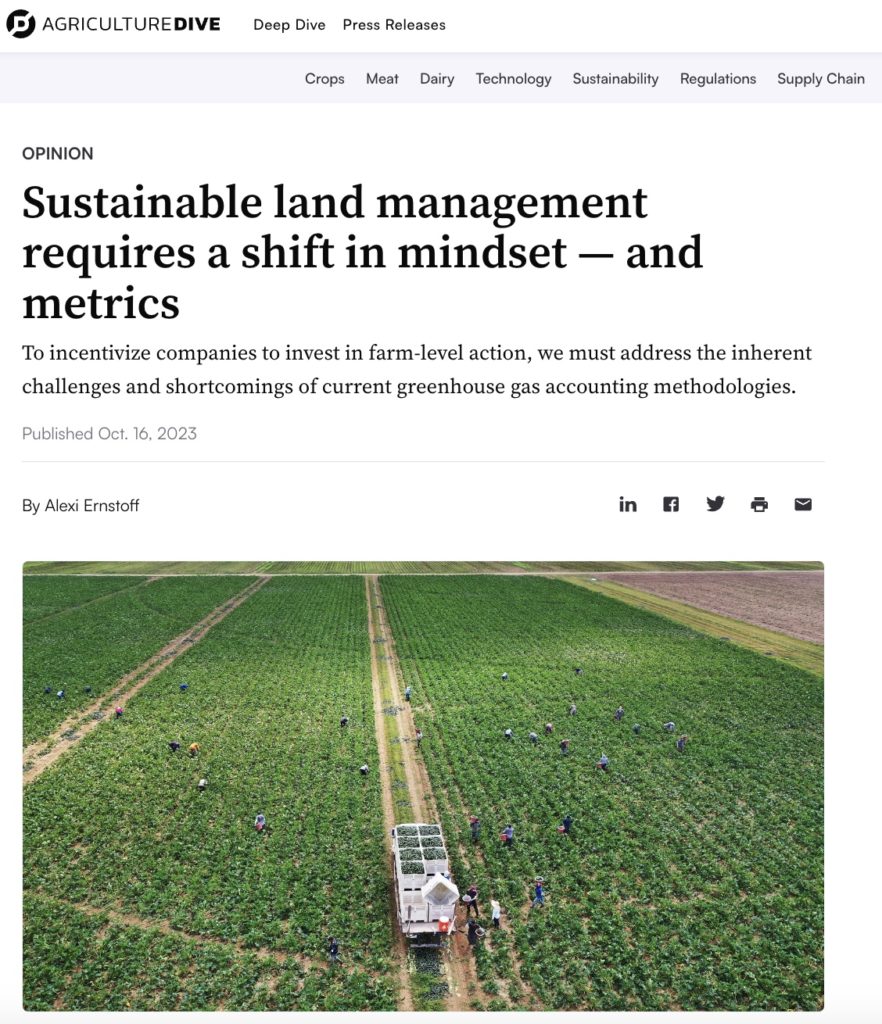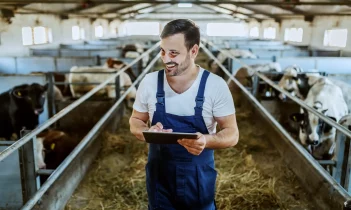*This article originally appeared in Agriculture Dive.
Agriculture Dive | Agricultural success today is closely linked to reduced environmental impact and increased resiliency as sustainability transforms perceptions of what the food system could look like. But there is still more we need to do to help agri-food businesses widely adopt improved practices such as regenerative or sustainable farming.
To incentivize companies to invest in farm-level action and to act outside their immediate supply chains (a practice dubbed landscape-level action or beyond value chain mitigation), we must address the inherent challenges and shortcomings of current greenhouse gas (GHG) accounting methodologies for forest, land and agriculture (FLAG) emissions.
Shifting the focus from product to land outcomes
It’s widely accepted that to achieve global climate targets and reverse nature loss, the private sector must support climate mitigation for both agricultural and forestry areas. Experts agree that taking action across landscapes and targeting key supply sheds are essential to tackle FLAG emissions. Such actions need to improve outcomes on expanses of land that include both productive and non-productive areas — rather than focusing action on individual farms or fragmented pockets of productive land.
But how companies get to account for actions (and investments) on land that is not 100% tied to their production supply chain remains a challenge. Current frameworks such as the GHG Protocol Land Sector and Removals Guidance (LSRG) and SBTi FLAG rely on product system accounting. This reporting convention requires companies to calculate their scope 3 emissions as the sum of emissions of purchased goods and services rather than outcomes on land transitioned to sustainable practice.
A product-system approach, however, doesn’t help to incentivize long-term land-level transition, and fails to address four important realities of the agri-food sector:
1. The industry is built on short-term relationships. Though there are many (small-scale) examples of long-term direct sourcing from farms, the vast majority of agri-food businesses source through intermediaries on short-term contracts. The transient nature of these relationships makes it difficult to build a strong business case for long-term transitions (and permanent monitoring of sequestered carbon, which the GHG Protocol LSRG requires).
Accounting rules should incentivize long-term changes, even in short-term supplier relationships.

2. Aggregation creates obstacles for traceability. To enhance efficiency and enable smallholders to meet standards and requirements, many farms aggregate crops into mills, cooperatives, or other types of collection points or processing facilities. This makes it difficult for agri-food businesses to trace back a given quantity of a good to specific farms, which violates the physical traceability requirement in the GHG Protocol LSRG for removals and direct land use change (dLUC) accounting.
3. Most farms are multi-output systems. Most farms — especially those implementing regenerative agriculture techniques — produce multiple crops using crop rotations or integrated systems. Yet most agri-food businesses only source a fraction of the farm’s output. Allocating the GHG emissions and removals of a farm system to one specific product doesn’t address the complexities of co-cropping, crop rotation, integrated animal agriculture and other regenerative agriculture practices.
Accounting rules and target-setting frameworks should incentivize full-farm transitions through individual or collective industry action.
4. Landscape-level action requires off-farm efforts. Key biodiversity and carbon gains often happen off farms, in areas with low agricultural productivity and high carbon or biodiversity opportunity costs. Though these frameworks limit companies’ ability to account for conservation efforts and other land management programs outside of their value chains, it’s critical work that’s still worth pursuing.
We need companies to go beyond their in-scope science-based targets and channel science-based investments towards mitigation activities that improve and protect land outside of their value chains. There’s a clear disconnect between what the science and sustainability community is asking for, the realities of the agri-food sector and the corporate reporting frameworks used to track progress.
Frameworks must evolve, but there’s no time to get distracted
To incentivize companies to invest in supporting farmers making the shift to more sustainable or regenerative agriculture, existing carbon accounting frameworks must evolve to become more relevant, operational and actionable.
The good news is efforts are already underway to better adapt and align guidelines with the realities of the agri-food sector. One example is “mass balance,” where companies account for emissions reduction actions carried out within a specific group of similar suppliers in proportion to the volume of goods purchased.
Yet the process of updating guidelines is a slow one. Resolving these issues and evolving standards to address the issues outlined here will take time and careful consideration to rule out the potential for greenwashing.
In the meantime, the imperative for action remains. If businesses already have the ability to trace their ingredients or raw materials back to specific farms, they should absolutely do so — especially for high-risk commodities, such as palm oil or cocoa. This will enable businesses to count GHG emission reductions through the GHG Protocol and FLAG guidance.
Landscape-level initiatives aimed at risk reduction and alignment with nature conservation objectives will also become important, especially the prevention of deforestation. Work with industry peers such as the Beyond Value Chain Mitigation Working group of the SBTi, Accountability Framework Initiative or the Value Change Initiative who can help bring clarity to the landscape-level action issue.
Amid the complexity of Scope 3 carbon reporting and accounting in FLAG emissions, the importance of investing in long-term land-level interventions to drive sustainable land management cannot be overstated. We must overcome accounting challenges. But these challenges should not delay immediate action to support farmers in their transition to more sustainable agriculture.
Latest resources

CO2 AI & Quantis release best-in-class product environmental footprinting solution for agri-food industry
Agri-food companies now have access to the most accurate solution for product environmental impact measurement and reduction.

Quantis supports FPE guidance for life cycle assessment of flexible packaging
Quantis and Flexible Packaging Europe issue new guidelines on the environmental assessment of flexible packaging.

Sustainable raw materials will drive profitability for fashion and app...
Philipp Meister, our Global Lead for Fashion & Sporting Goods and Jocelyn Wilkinson, BCG's Partner and Associate Director, jointly discuss the challenges of sustainable raw...

